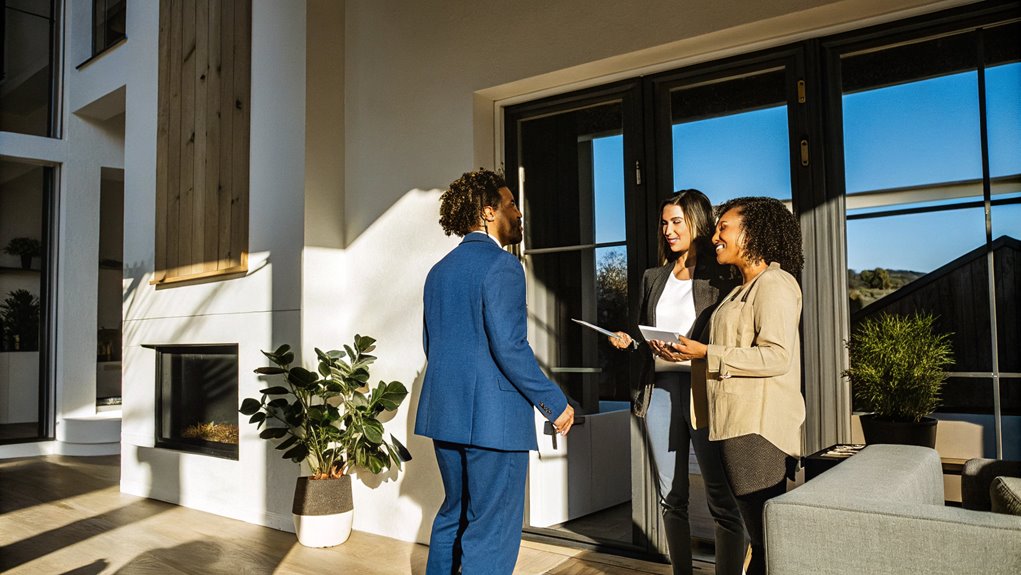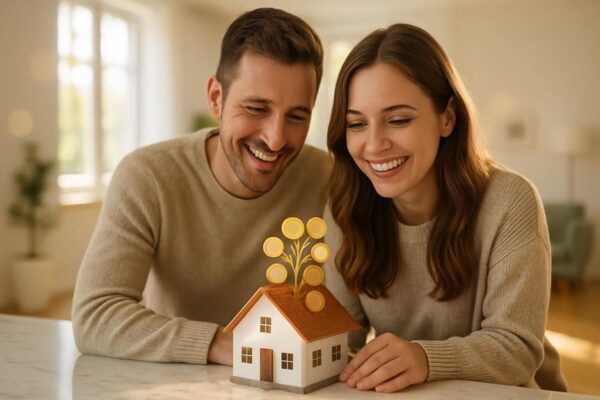When you skip open houses while looking for a home, you might miss out on a great deal. Pictures online can show you what a house looks like. But they can't show you everything you need to know. Walking through a house helps you see problems like cracks or damage. You can see how sunny the rooms are. You can check if the rooms flow well when you walk from one to the next. You also get to meet the people selling the house. They can tell you about the street and area. All of this helps you know if the price is fair. It also helps you plan for living in the house.
Ready to start building equity in your own Michigan home? Get your personalized home loan quote today.
Experience the Space Firsthand

Walking through a real home is better than looking at pictures online. Sure, you can see photos and videos, but being there feels different.
When you walk into each room, you notice things you can't see in photos. You'll feel how sunny the rooms are. You can hear if the street is noisy. You'll see if the kitchen works well for you. The bedroom might feel cozy or not quite right. You might spot old power outlets or smell strange odors that photos don't show. Some floors might creak when you step on them.
Going to see a home helps you make a better choice. You won't feel sorry later because you know exactly what you're buying.
Don't miss out on your dream home – go see it in person.
Michigan residents, unlock the door to your new home. Request your home loan quote from Treeside Financial today.
Meet the Selling Agent Directly
When you meet the selling agent face to face, you make a real friend. This is better than just being one more person at an open house.
The agent will see that you want to buy and will talk more with you. You can ask lots of questions about the house and its price when you meet alone.
The agent can tell you things they mightn't say at a busy open house.
Build Instant Professional Rapport
Meeting with a home's selling agent face-to-face helps you stand out. Many buyers only go to open houses. But you can do better. Ask for a private tour when you really want to buy the home.
Ways to Make Friends with the Agent:
- Ask smart questions about homes in the area
- Tell them you are ready to buy
- Pay attention when they talk
- Keep in touch clearly
When you meet one-on-one, the agent sees you care about buying. They know you're not just looking around. They can tell you know what you want and you're ready to buy when you find the right home.
| What to Do | Why It Helps |
|---|---|
| Ask good questions | Shows you know houses |
| Say you can buy now | Proves you mean it |
| Listen well | Makes them like you |
| Stay in touch | Shows you're serious |
Negotiate Face to Face
Meeting face to face with the home seller's agent is a great way to buy a house. When you sit down with them, you can make a real friend. This works much better than just sending emails or making phone calls.
When you meet in person, you can watch how the agent acts and talks. This helps you know if they really want to sell the house. You can ask them lots of good questions about the house. You might learn about new fixes they made or problems you need to know about.
The agent will see that you really want to buy the house when you meet them. This helps both sides work better together. You might even get a better price for the house.
You might be closer to buying your home than you think
Take our 2-minute home buyer readiness quiz to see how prepared you really are – no credit check required.

Spot Hidden Red Flags

When you check out a home, be like a detective. Look hard for problems that hide from quick looks.
Watch for wobbly floors and doors that stick – these could mean the house has a bad base. Look up and down for dark spots on walls and ceilings. Sniff for weird smells.
These bad signs mean water got in. If you miss these things, fixing them later will cost you lots of money.
Take your time to look at every part of the house before you try to buy it.
Structural Issues Lurk Beneath
Picture yourself walking into a home. You'd want to check for problems hiding in the walls and floors. If you skip visiting the house first, you might miss things that can cost you lots of money later.
You need to use your own eyes to spot the signs. Look for cracks in walls. Feel if the floor isn't flat. Smell for any bad odors. Watch if doors close right. Try opening and closing windows to see if they work well.
These small signs can tell you about big problems in the house. Photos can't show you these things. You must walk through the home yourself to find what might be wrong.
Foundation and Water Damage
Foundation and Water Problems
When you walk through a house you want to buy, you need to look for big problems that can hurt your home. Two of the worst problems are foundation issues and water damage.
When you visit the house, take time to look at things you can't see in pictures. Walk on the floors to see if they feel even. Look at the walls for cracks. Use your nose to smell for wet, musty odors.
If you miss these problems:
- You'll feel very sad if you find cracks after you buy the house
- Your family could get sick from mold that grows from water damage
- You might've to pay a lot of money to fix these problems
- Your house might lose value when you try to sell it
Remember to focus on checking these important parts of the house. Don't let a pretty kitchen or nice living room make you forget to look for problems.
Assess the Neighborhood Environment
Look carefully at the area around any house you want to buy. Your home's value and your daily life depend on having good neighbors and a nice area.
Go to open houses when people are busy outdoors. Watch how cars move on the streets. Listen to how loud it is. See how friendly the people are who live there.
Walk around to find shops, parks, and schools nearby. Look at other houses to see if they're clean and fixed up. Bad signs are empty buildings or broken streets and sidewalks.
Talk to people who live there. Ask if they feel safe. See what the area feels like to you. A house is more than just walls and rooms – it's part of a bigger group of people and places that will be your new home.
Compare Multiple Properties Efficiently

Looking at lots of homes can get confusing. Make it easy on yourself – grab a piece of paper or open your computer.
Write down what each home has: how big it is, how many rooms, and the cool stuff you want in a home. This way you can look at many homes all at once. It's better than trying to remember each home in your head.
Look at what other homes cost nearby too. This helps you find good deals and know when to ask for a lower price.
Side-by-Side Home Features
Looking at homes side by side helps you pick the right one. When you list all the things about each house, you can see what makes them different. This helps you choose before you visit them.
Make a simple list of what each house has:
- How many bedrooms
- How big the yard is
- What the kitchen looks like
- How much it costs
This helps you in four ways:
- You can see more houses than just going to open houses
- You won't fall in love with a house just by looking at it
- You save time by picking only the best houses to visit
- You know what each house is worth when you talk about price
Writing down what each house has helps you make better choices. You won't get confused by how pretty a house looks when you visit. Instead, you can focus on what matters most to you.
Quick Multi-Home Price Analysis
When you look at many homes at once, you can see things you might miss by seeing just one home. Going to open houses lets you walk through homes in the same area on the same day. This helps you see which homes cost more or less than others.
As you walk through these homes, you learn what makes some homes cost more. You can see why two homes that look the same might've different prices. Things like where the home is, new parts in the home, and yard size change the price.
Walking through many homes helps you learn what homes should really cost. This makes you smarter when you want to buy a home.
Observe Natural Light Patterns
Light Changes Your Home Life
The sun's path through a home matters more than most people think. When you only look at a house on a screen, you miss how light moves through rooms as the day goes on. This can lead to big letdowns after you move in.
Think about what you might miss:
- A dark kitchen where you need lights on to cook, even at lunch time
- Too much bright sun in your work space that hurts your eyes
- The nice warm light that could fill your living room as you drink your morning coffee
- Sweet sunny spots where you could sit and read a good book
Looking at a home on a screen won't show you how bright or dark it really is. The way sun moves through your home affects how you feel each day and how much you pay for power.
Feel the Home's Energy

Walk through each room slowly when you visit the home.
See how rooms connect to each other.
Watch how the sun comes in through the windows.
Think about if the light makes you feel cozy and happy.
Listen to the sounds outside.
Are kids playing?
Do cars drive by?
All of this helps you know if this house feels right for you.
Experience the Natural Light
Light Makes a Home Feel Special
When you step into a home, look at how the sun shines inside. The way light flows into rooms can make you feel happy or sad. It's smart to visit a house in person to see how the light moves during the day.
Look for:
- How the morning sun lights up the kitchen when you eat your toast
- Where the sun warms your living room when you rest
- The way shadows move in the yard when you want to play
- Any dark spots that need more lamps
Photos can't show you how light really feels in a home. You need to see it with your own eyes.
Sense Room Flow Patterns
When you walk through a home, you need to feel how easy it will be to live there. Watch how the kitchen leads to where you eat. Check if the halls feel too small. See if bedrooms are far from noisy spaces.
Think about your daily life in the home. Can you carry bags from your car to the kitchen? Will your friends find the bathroom with no trouble? Look at where the chairs and sofa fit. Each room should connect to the next in a way that makes sense.
This is a big deal when picking a home. If something feels wrong on your first look, it will bug you every day when you live there.
Notice Neighborhood Activity
Watch your new street closely to see what life is like there. You want to know how people live in this area before you buy a house.
Take a walk and look at what happens each day:
See the parents walking kids to school in the morning.
Look for people walking dogs or talking to neighbors.
Check if yards and homes look neat and cared for.
Watch how many cars drive by and how fast they go.
You can learn a lot just by being there.
Look for:
Kids playing and laughing at the park.
People saying hello to each other.
Clean and tidy houses.
Safe and quiet streets.
Looking at pictures online won't show you these things. Being there helps you know if this street feels like home.
Discover Unique Property Features
When you step into a home, you'll see things that photos miss.
Watch how the sun moves through each room. Feel the smooth touch of fancy wood and stone used in quiet corners. Look for smart storage spots built into walls and pretty details that show the home's past.
You might find cool features others don't see. Maybe there's a cozy spot for morning coffee.
Or new parts that help save money on bills. These small things can make a normal house feel just right for you.
That's why seeing a home in real life is so important – you get to find all its special secrets.
Network With Other Buyers

Meeting other home buyers at open houses is a great way to make friends. You can talk to people who want the same things you do in a home. They know a lot about houses and prices in the area.
You can:
- Ask buyers what they think about homes they saw
- Share phone numbers to tell each other about new houses for sale
- Make friends who might know about homes not listed yet
- Talk to people who bought homes nearby about what worked for them
These new friends can help you find the right home. They know what it's like to look for a house. Plus, they can tell you cool things about the area you want to live in.
Learn Market Trends
Looking at houses in your area helps you learn what's happening in the real estate market.
When you visit open houses, you can see the homes up close and learn a lot. You can find out how much homes cost in the area you like. You can see how many other people want to buy there too.
Open houses show you what makes some homes sell fast and cost more than others.
Evaluate Room Flow

A good home needs rooms that work well together. When you look at a house, walk through all the rooms. See how easy it's to move from one room to the next. This is more helpful than looking at photos.
Think about these things as you walk:
- Can you get from the kitchen to where you eat without bumps or turns?
- Are the bedrooms far from noisy areas?
- Is it easy to get from your bed to the bathroom?
- Does the front door area feel warm and nice when you walk in?
The way rooms connect helps you live better in your home. It makes a big change in how happy you feel each day.
Take time to walk through the whole house. Move around like you'd if you lived there. This will show you if the house fits how you want to live.
Check Construction Quality
When you visit a house, look closely at how it's built. Walk around and touch the walls – are they smooth or do they've cracks? Check if the floor feels solid under your feet.
Look up at the ceiling and down at the floor to spot any damage. Water can hurt houses, so look for dark spots or stains. These could mean trouble.
Test all the doors to see if they open and close well. Look at the windows too – do they keep the cold air out?
Don't forget to check where walls meet in corners. Sometimes these areas show if a house has big problems.
Take your time to open closets and look in every room. You can find things in person that you might miss in pictures.
Negotiate With Inside Knowledge

When you want to buy a home, knowing a lot about it helps you get a better price. You must visit the home in person. Looking at pictures isn't enough.
Going to see the home lets you find things that could help you pay less:
- You might see messy yards next door
- You could hear loud trains early in the morning
- You may spot marks from old leaks on walls
- You can see what needs to be fixed
These things help you talk about the price with the seller. A smart buyer looks for both good and bad things about the home.
When you know more about the home, you can make a better deal. Walking through the home helps you see things you'd miss in photos. This helps you and the seller agree on a fair price.
Identify Potential Renovation Opportunities
When you walk through a home, you can find ways to make it better.
Going to see homes in person lets you spot good chances to fix them up. You might see walls you can take down to make rooms bigger.
Or you might find an empty attic that could become a new bedroom. These changes can make the home worth more money.
Simple fixes can turn an okay home into a great one.








